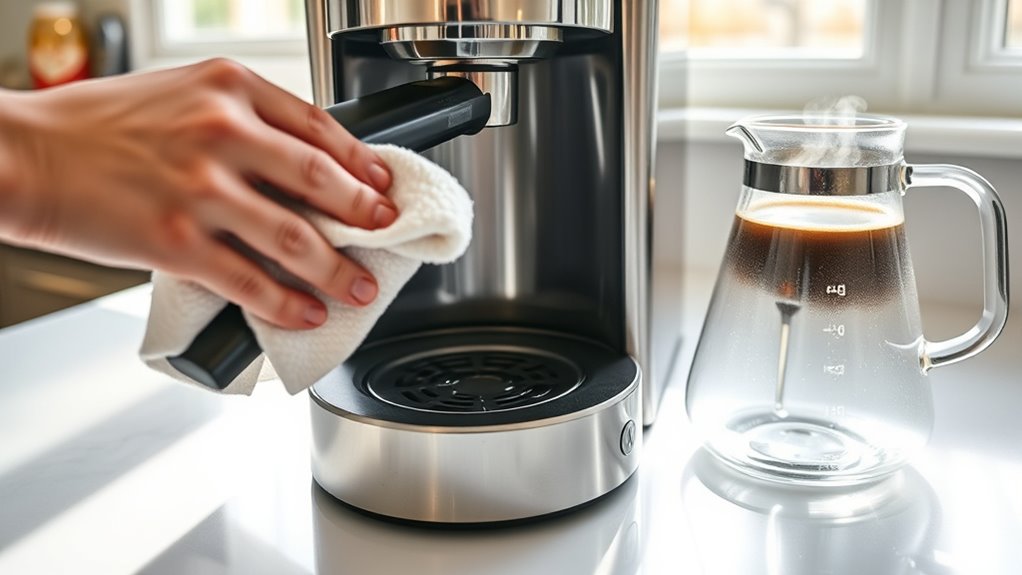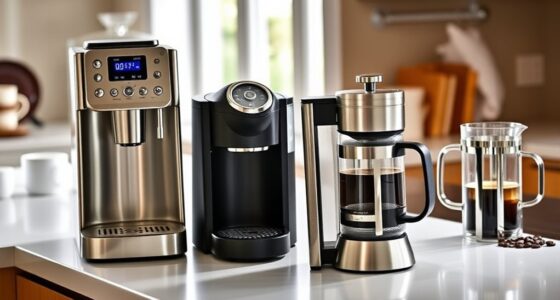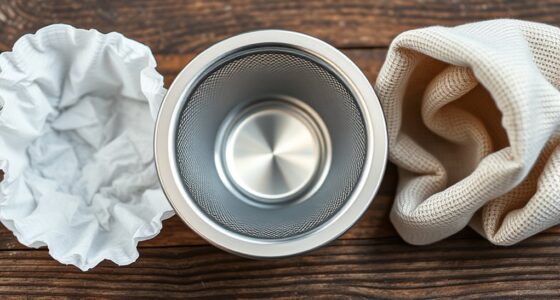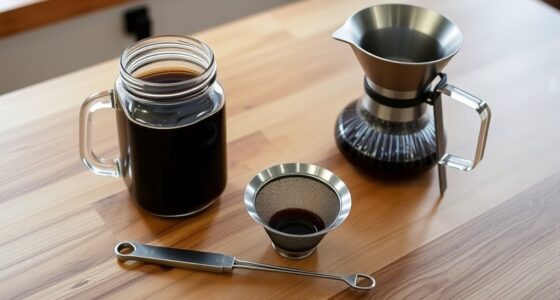To improve your coffee’s flavor, regularly clean and descale your coffee maker. Use equal parts white vinegar and water to run a brew cycle, then follow with plain water cycles to rinse. Clean drip trays, brew baskets, and exterior parts frequently to prevent mold and residue buildup. Adjust your cleaning schedule based on water hardness and usage, and watch for signs like strange tastes or slower brewing. Keep your machine in top shape—more tips await to help you brew your best coffee every time.
Key Takeaways
- Regularly descale your coffee maker using vinegar or commercial solutions to prevent mineral buildup and maintain optimal flavor.
- Clean removable parts like brew baskets and drip trays frequently to avoid mold, residue, and bacteria.
- Adjust cleaning frequency based on water hardness and usage, with hard water requiring more frequent descaling.
- Run a brew cycle with vinegar or descaling solution followed by plain water to thoroughly clean internal components.
- Keep the exterior clean and set maintenance reminders to ensure consistent performance and better-tasting coffee.
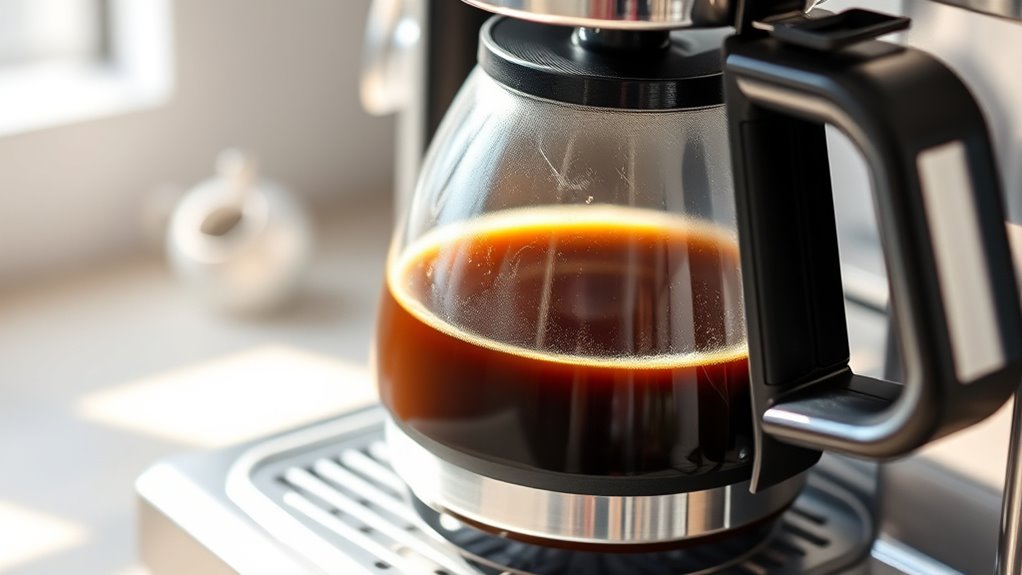
A clean coffee maker is essential for brewing great-tasting coffee and maintaining your machine’s longevity. Regularly descaling your coffee maker is a key part of that upkeep, ensuring mineral buildup doesn’t affect performance or flavor. When it comes to descaling methods, you have several options, but the goal remains the same: remove those stubborn deposits that can clog your machine and compromise the taste of your brew. Many people opt for vinegar because it’s effective, inexpensive, and readily available. To do this, fill the water reservoir with equal parts white vinegar and water, then run a brew cycle without coffee. Follow that by running two or three plain water cycles to rinse out any residual vinegar. Alternatively, commercial descaling solutions designed specifically for coffee makers can also be highly effective and might be less odorous. Whichever method you choose, it’s important to do it regularly—at least once every three to four months—to keep mineral buildup at bay.
Determining the right cleaning frequency depends on factors like your water hardness and how often you use your machine. If you have hard water, you might need to descale more often, perhaps monthly, to prevent scale accumulation. Soft water, on the other hand, allows for a longer interval between descales. Keep an eye on your coffee maker’s performance; if you notice slower brewing times, strange tastes, or foul odors, it’s a clear sign it’s time for a descale. Developing a routine for descaling and cleaning helps prevent bigger problems down the line and keeps your coffee tasting fresh and rich. Additionally, using proper placement of your coffee maker can improve airflow and prevent dust accumulation, contributing to better maintenance and performance.
In addition to descaling, you should also incorporate regular cleaning of other parts of your coffee maker. Wipe down the exterior, clean the drip tray, and rinse the brew basket frequently to prevent mold, bacteria, and residue buildup. Using a mild detergent or specialized cleaning tablets can help keep these parts in ideal condition. If you ignore these steps, your machine can develop mold or mold spores, which not only affect flavor but could pose health risks. To simplify your routine, consider setting reminders for descaling and cleaning, especially if you use your coffee maker daily. This proactive approach can also extend to understanding regulations and compliance related to appliance maintenance, ensuring your machine remains safe to use. This way, you stay on top of maintenance, ensuring every cup you brew is as good as it can be. Remember, a little effort goes a long way in extending your coffee maker’s lifespan and enhancing your coffee experience.
Frequently Asked Questions
How Often Should I Clean My Coffee Maker?
You should clean your coffee maker regularly to maintain ideal coffee quality. For coffee maintenance and brewing efficiency, aim to clean it at least once a month. If you use it daily, consider more frequent cleaning, like every two weeks. Regular cleaning prevents buildup of mineral deposits and old coffee oils, ensuring each brew tastes fresh and your machine functions smoothly. Staying consistent helps prolong your coffee maker’s lifespan.
Can I Use Vinegar for Descaling?
Yes, you can use vinegar for descaling your coffee maker, but you should consider vinegar safety first. Vinegar is a safe, natural descaling agent that effectively removes mineral buildup. To guarantee descaling effectiveness, run a mixture of equal parts vinegar and water through your machine, then rinse thoroughly. This process helps maintain your coffee maker’s performance and extends its lifespan without harmful chemicals.
Are There Natural Cleaning Alternatives?
You’re wondering if natural solutions and eco-friendly methods can clean your coffee maker. Yes, they can! Vinegar and baking soda are popular, safe options that effectively remove buildup without harsh chemicals. Simply run a vinegar rinse or a baking soda solution through your machine, then rinse thoroughly. These methods are not only eco-friendly but also cost-effective, keeping your coffee tasting fresh while protecting the environment.
How Do I Clean Hard-To-Reach Parts?
When cleaning hard-to-reach parts, you should use a small cleaning brush to scrub areas like water filters and inside narrow tubes. Remove water filters carefully and soak them in vinegar or a gentle cleaner. Use a brush to loosen any buildup, then rinse thoroughly. This guarantees all residue is gone, and your coffee maker stays fresh. Regular cleaning with these tools keeps your brew tasting great and prolongs your machine’s life.
Will Cleaning Improve Coffee Flavor Significantly?
Think of your coffee maker as a musical instrument; when it’s clean, it plays a pure, vibrant tune. Cleaning removes mineral buildup, much like tuning strings, which can dull your coffee flavor. Yes, regular cleaning can notably improve your brew, revealing richer aroma and smoother taste. Neglecting it leaves residues that mask the true flavor, so keep your machine in harmony for the best coffee experience.
Conclusion
Now that you know how to clean your coffee maker, brewing a fresh, tasty cup becomes easier than ever. Regular cleaning keeps your machine running smoothly, much like a well-oiled engine, ensuring every sip is full of flavor. Think of it as giving your coffee maker a little spa day—it’ll thank you with better-tasting coffee. So, stay consistent, and enjoy mornings filled with rich, delightful brews every time.
